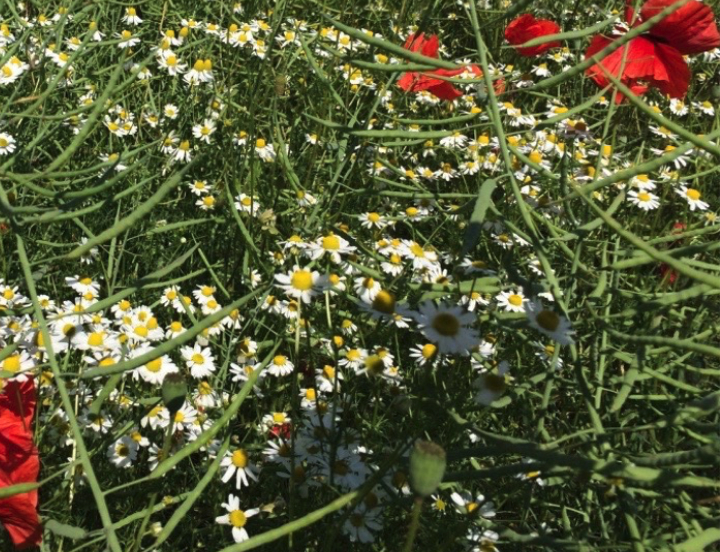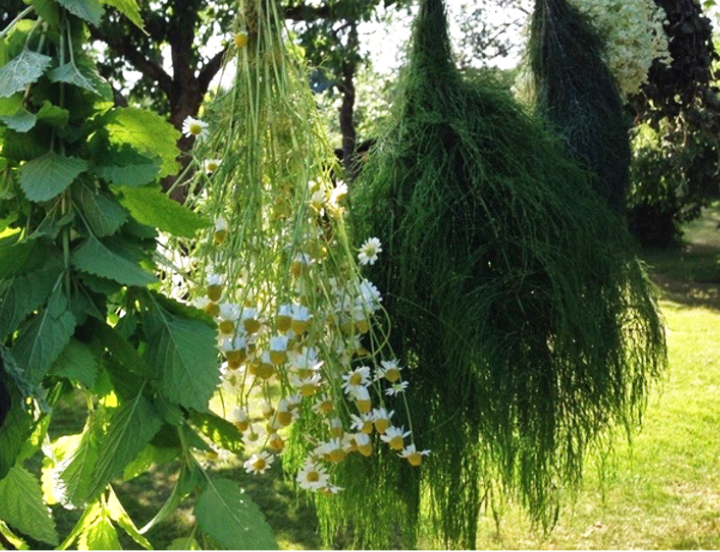Curtains up for one of our very favorite medicinal plants.
As you can see in the picture already, today we want to talk a little about chamomile.
You've probably already noticed that, depending on the season, we always have our favorite wild herbs.
Since the annual debut of certain plants occurs only for a short period, we have to be really quick with harvesting and processing.
As you can see - at the moment we are into chamomiles and strawberries.
On our trip to the strawberry field, we happened to see huge gorgeous blooming chamomile fields.
You can mostly find them embedded between poppies and grains.
What a colorful sight.

As lovers of chamomile, we need to invest a little time in the harvest to free the flowers from the stems.
But the work pays off in any case.
For drying in warm weather, we put the flower buds in an even layer on a baking sheet in a shady place outside or hang the whole plant upside down.

We always have several glasses in the cabinet which keep us through the cold season.
Unfortunately, chamomile is losing a bit of the attention nowadays, although it is said to be one of the best investigated medicinal plants.
For instance a lot of times, I witnessed that chamomile tea drinkers are being asked whether they are sick.
But the small white - yellow flowers can be much more that just act for medicinal purposes.
You can integrate them in all kinds of other things as you can see in some examples below.
Luckily, in naturopathy, people are still aware of the healing benefits of this fragrant plant.
The essential oils of the chamomile have an anti-inflammatory effect and can kill bacteria.
It can also help with a nervous stomach, intestinal disorders, bloating or discomfort with the stomach acid.
Especially in stressful situations, chamomile is simply unbeatable.
Its valuable flavonoids act antispasmodic and calming.
Here are a few examples for the use of this wonderful plant:
Perhaps chamomile tea is the most known use of taking chamomile.
It reduces inflammation and helps with sleeping disorders and flu symptoms such as cough, hoarseness and a running nose.
Also with diarrhea or a nervous stomach, a chamomile tea is unlikely beneficial.
For the preparation, take a few chamomile flowers and douse them with hot, but not boiling water, and allow them to soak for 10 minutes. Then strain through a sieve and enjoy.
Chamomile can also be used as a natural color refresher for light hair.
Prepare a chamomile tea (about 4 tablespoons of flowers in a pint of water), add a tablespoon of freshly squeezed lemon juice and let it rest for 30 minutes.
Massage it in your freshly washed hair and let it air dry (without rinsing).
In combination with the sun, it will naturally lighten your hair.
As we already mentioned, we always keep chamomile in our kitchen cupboard.
In particular, we use it for tea and very often for inhalation.
For this, we boil a liter of chamomile tea and fill it in a pot.
Then we put a towel over the head and steam the face for about ten minutes.
This cleans the upper airways and soothes the mucous membranes.
Did you have a stressful day?
Then we recommend you a fragrant chamomile bath.
Brew a big pot of chamomile tea and add it to the bath water.
This will calm you down and is good for the skin and adds a wonderful smell.
You can also process the little flowers in a smoothie.
Just prepare your favorite green smoothie from vegetables and some fruit and add a handful of chamomile flowers.
In that way, you get the full plant power.
If you prefer to buy chamomile, please pay attention to only using high quality herbs.
To a healthy and relexing new week!
What are you using chamomile for?
We love to hear from you.
PS:
Follow us on social media: